When I lived in Los Angeles, one of my favorite weekend escapes was the Hunting Gardens in Pasadena. Just a short drive from the city, it offered a peaceful mix of cactus trails, bamboo groves, and camelia walks – each garden reflecting a different part of the world.
That feeling of stepping into another place entirely – without boarding a plane – has always stayed with me. And it’s that same sense of wonder we’re exploring today, with gardens around the world that blend natural beauty with cultural expression.
At Remitly, we know that discovering a new culture isn’t just about where you live – it’s about how you connect. That’s why we share guides that highlight the beauty of nature, art, and everyday life around the world – helping you explore without leaving your home.
In this guide, we’re showcasing some of the world’s most beautiful gardens, along with practical tips for planning your next botanical adventure.
North America: from tropical paradise to cultivated elegance
North America’s landscape is rich and varied, shifting dramatically from one state to the next. From California’s sun-soaked deserts and rugged coastlines to the misty harbors of Victoria, Canada, this vast continent is home to a wide range of ecosystems.
But if a cross-country road trip isn’t in the cards, a botanical garden can offer the same sense of discovery – taking you on a journey through North America and beyond.
The Huntington, Pasadena, California, USA
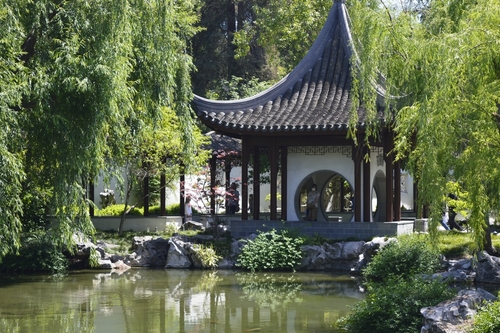
The Huntington Botanical Gardens isn’t just a garden; it’s also a library and museum. Its motto – “Where history, literature, art, and the natural world coalesce” – captures the spirit of this one-of-a-kind destination.
The gardens span over 130 acres. If you’re short on time, here are a few highlights worth prioritizing:
- Japanese Garden: tranquil koi ponds, bonsai collections, and a classic zen layout.
- Desert Garden: one of the world’s oldest and largest collections of cacti.
- Chinese Garden (Liu Fan Yuan): inspired by the traditional gardens of Suzhou, near Shanghai.
If you have time to linger, end your visit with a stroll through the Shakespeare rose garden – and perhaps an afternoon tea at the Rose Garden Tea Room.
Longwood Gardens, Pennsylvania, USA
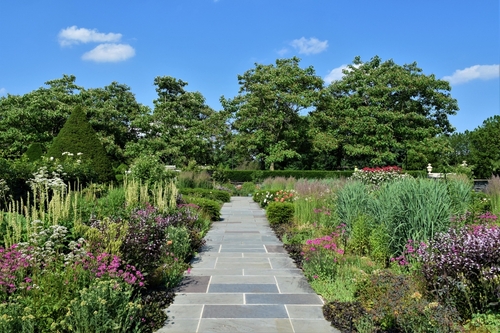
Often ranked among the top gardens in the United States, Longwood Gardens is known for its seasonal floral displays, spectacular fountain shows, and expansive indoor conservatories.
From late spring through fall, visitors can enjoy weekend fountain shows choreographed to music – a highlight that draws visitors from around the world.
Some must-see features include:
- Conservatories: Over 1,300 plants are grown each year in the greenhouses and gardens.
- Thousand Bloom Chrysanthemum: During the annual Chrysanthemum Festival, gardeners grow this rare spectacle where hundreds of blooms emerge from a single stem.
- Fountains and water features: One of the largest fountain collections in the US, with regular summer performances choreographed to music.
Butchart Gardens, Victoria, Canada
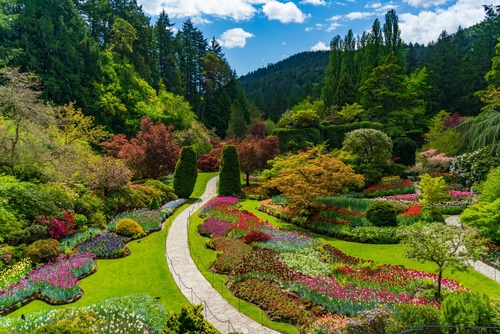
Set against the natural beauty of British Columbia, Butchart Gardens is one of the most celebrated botanical destinations in the world. Once a limestone quarry, it was repurposed by Jennie Butchart in the early 20th century – and is now recognized as a Natural Historical Site of Canada.
Today, visitors can explore themed gardens featuring plants from around the globe, all thoughtfully arranged across 55 acres of landscaped beauty.
Highlights include:
- Sunken garden: Built into the site of the original quarry, this dramatic space is steeped in history.
- Rose garden: Home to more than 2,500 rose plants and seven distinct varieties – perfect for a summer visit.
- Japanese garden: This peaceful area spans more than an acre and is lined with maple trees and over 500 rhododendrons.
Asia: where tradition meets tranquility
Asia is home to some of the world’s most thoughtfully designed gardens – spaces that offer calm and reflection amid the energy of urban life.
From minimalist Zen rock gardens to lush tropical sanctuaries, these green spaces highlight the region’s deep-rooted connection between nature, art, and philosophy.
Ryoan-ji Temple Garden, Kyoto, Japan
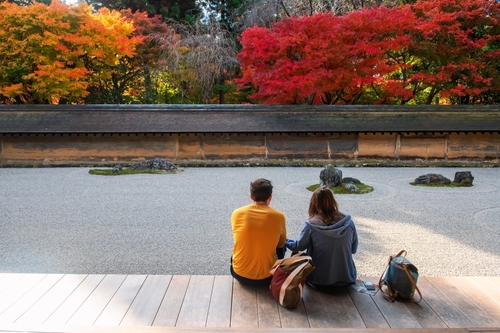
Ryoan-ji is one of the most iconic Zen gardens in Japan – a place where stillness and simplicity invite quiet reflection. As you walk across its grounds, the sound of gravel underfoot becomes part of the meditative experience.
The temple was converted from an aristocrat’s villa in 1450, and while the exact origins of the rock garden remain unclear, its 15 carefully placed stones have long inspired contemplation and calm.
Tips for visiting:
- Best time to go: Late fall, when the air is crisp and the surrounding maple trees turn brilliant shades of red and gold.
- Plan ahead: As a UNESCO World Heritage Site, Ryoan-ji attracts many visitors. Arriving early or on a weekday can help you enjoy the quiet atmosphere.
- Explore nearby: While not a traditional botanical garden, Ryoan-ji is surrounded by a tranquil park and pond that offer more chances to connect with nature.
Gardens by the Bay, Singapore
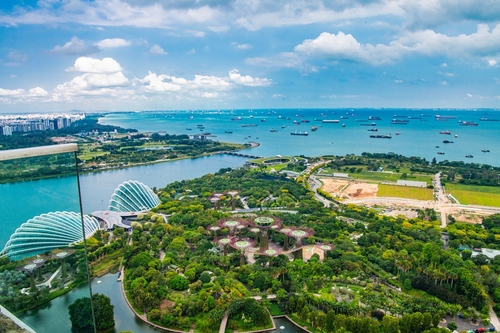
With glowing Supertrees that light up the night sky, Gardens by the Bay feels like a glimpse into the future. This iconic site blends nature and technology in one of the world’s most innovative green spaces.
The gardens are home to two vast conservatories, dramatic indoor waterfalls, and one of the largest greenhouse structures ever built – making it a must-see for those exploring Singapore.
Highlights include:
- Cloud Forest Dome: Home to the world’s largest indoor waterfall, surrounded by misty walkways and rare plant species.
- Flower Dome: Recognized by Guinness World Records as the largest glass greenhouse in the world, featuring plants from Mediterranean and semi-arid regions.
- Supertree Grove: These towering vertical gardens generate solar power, collect rainwater, and host evening light and sound shows.
Europe: centuries of horticultural mastery
From classic English gardens to the vibrant tulip fields of the Netherlands, Europe has a long tradition of crafting green spaces that combine beauty, history, and innovation – not just for royalty, but for everyone to enjoy.
There’s no shortage of remarkable gardens across the continent, but the two featured here – in the Netherlands and France – offer especially memorable experiences for garden lovers.
Keukenhof Gardens, Lisse, Netherlands
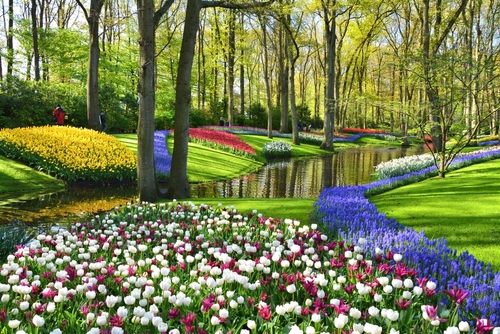
Each spring, Keukenhof bursts into bloom with more than seven million tulip bulbs – creating one of Europe’s most spectacular floral displays. These colorful fields are iconic in the Netherlands and offer a vivid glimpse into Dutch horticultural heritage.
Visiting tips:
- Best time to go: The garden is open from mid-March to mid-May, with peak bloom typically in mid-April.
- Book ahead: Entry times can sell out quickly during the height of the season.
- Explore by bike: Rent a bicycle to ride through the surrounding flower fields for a scenic experience beyond the main gardens.
Claude Monet’s House and Gardens, Giverny, France
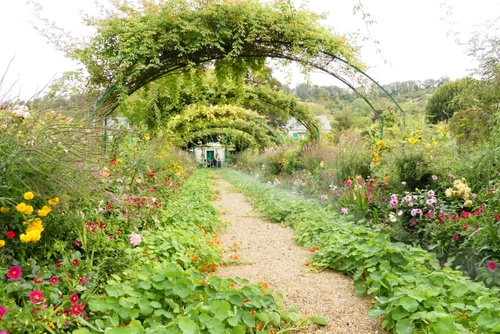
Claude Monet, one of the leading figures of the Impressionist movement, lived in this charming house in Giverny for over four decades. Today, his home and gardens – known in French as Maison et jardins de Claude Monet – offer a glimpse into the landscapes that inspired many of his most famous paintings.
The gardens were personally designed by Monet, with bold plant combinations that echo the vivid colors and fluid forms of his art.
Highlights include:
- Garden design: Monet chose plant species from around the world, focusing on color and texture over symmetry.
- Artistic legacy: He lived in the house for 43 years, carefully shaping the gardens as a living canvas.
- Seasonal blooms: Irises in spring, roses in early summer, and dahlias and sunflowers in late summer.
Africa & Middle East: ancient wisdom in modern landscapes
Across Africa and the Middle East, botanical gardens reflect both the resilience of desert plants and the richness of lush, forested ecosystems. These regions are home to an extraordinary range of native species, many of which have adapted to thrive in extreme climates.
Kirstenbosch National Botanical Garden, Cape Town, South Africa
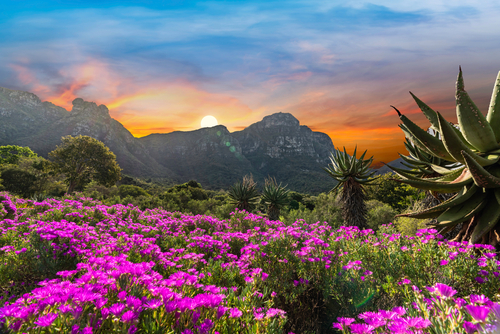
Located on the eastern slopes of Cape Town’s iconic Table Mountain, Kirstenbosch is dedicated entirely to indigenous South African flora – making it one of the most ecologically significant gardens on the continent.
What sets it apart:
- Unique biodiversity: Home exclusively to South African plant species, many of which can’t be grown elsewhere.
- Boomslang walkway: A treetop bridge that winds through the canopy, offering panoramic views of the gardens and mountains.
- Conservation focus: Active programs protect rare plants like fynbos and cycads, contributing to global biodiversity efforts.
Majorelle Garden, Marrakech, Morocco
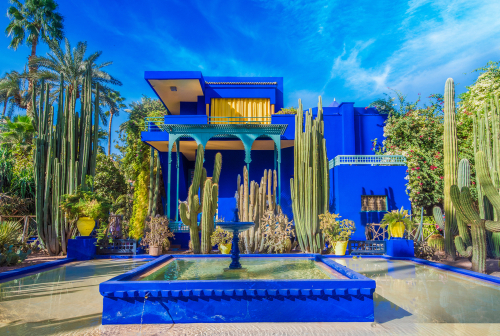
With its bold cobalt-blue walls, sculptural cacti, and peaceful layout, Majorelle Garden is one of the most visually recognizable gardens in the world. Created by French painter Jacques Majorelle in the 1920s, it was later restored by fashion designer Yves Saint Laurent, who helped preserve its legacy.
The garden blends North African botanical elements with artistic design, creating a vibrant and meditative space in the heart of Marrakech.
Highlights include:
- Majorelle blue: The signature shade used throughout the garden creates a dreamlike atmosphere that contrasts beautifully with the desert surroundings.
- Global plantings: North African species mix with bamboo, water lilies, and tropical plants from around the world.
- Yves Saint Laurent Museum: Adjacent to the garden, this museum celebrates the designer’s work and showcases his love of color and natural forms.
Oceania: island paradise gardens
Australia is home to some of the world’s most diverse ecosystems, from dry deserts to tropical rainforests – and even lush coastal gardens in the heart of its cities. In Sydney, one of the region’s most beloved green spaces offers visitors a peaceful blend of native flora, history, and waterfront views.
Royal Botanic Gardens, Sydney, Australia
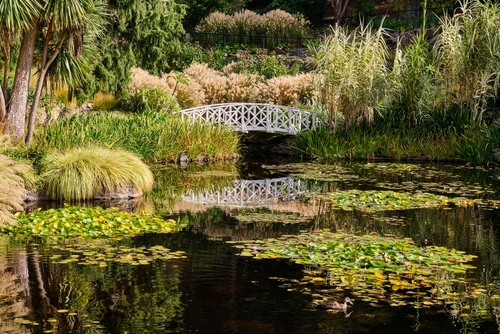
Situated along the Sydney Harbour and just a short walk from the Opera House, this garden is both a public escape and a vital conservation site. It welcomes tourists, locals, and researchers alike with its blend of science, storytelling, and stunning plant life.
Unique features:
- Australian rainforest garden: Highlights plant species native to Australia’s tropical and subtropical regions.
- Cadi Jam Ora – First Encounters: This interpretive walkway shares Aboriginal perspectives on the land and its layered history.
- Research and conservation: The garden’s seed banking and biodiversity programs support global efforts to protect threatened species.
Planning your garden adventures
Most gardens are at their most vibrant in spring and early summer, when blooms reach their peak. Timing your visit with the season can make all the difference.
Here’s a quick guide to what you’ll find in bloom throughout the year:
- Spring: Tulips in the Netherlands; cherry blossoms in Japan
- Summer: Roses in Canada; lavender in France
- Fall: Fiery maples in Japan; golden wildflowers in California
- Winter: Light festivals in Canadian and European gardens
Garden etiquette
Many gardens welcome photos and up-close viewing – but to keep these spaces thriving for future visitors, a few simple rules go a long way:
- Stay on marked paths: Stepping into flower beds can damage fragile ecosystems.
- Use trash cans: Keep gardens tidy by disposing of litter properly.
- Avoid flash photography: Especially in greenhouses and conservatories, where it can disrupt pollinators.
- Respect local guidelines: Follow garden signs and consider donating to support conservation and upkeep.
Accessibility
Many gardens are designed with accessibility in mind, though certain areas may still be challenging to navigate, especially larger or historic sites.
Before your visit, it’s worth checking the garden’s size and layout – some involve long walking routes or uneven paths.
If you require additional support, contact the garden in advance or visit its website. Some, like the Huntington, offer detailed accessibility information and staff assistance.
Are There Gardens That Offer Stunning Fall Foliage Experiences?
Discover the beauty of nature’s palette at gardens that offer stunning fall foliage experiences. These vibrant landscapes transform into a feast for the eyes, inviting visitors to embark on unforgettable autumn leaf adventures. Enjoy picturesque strolls, vibrant colors, and serene surroundings that celebrate the magic of the autumn season.
Discover the world through its gardens
Whether it’s a centuries-old estate or a cutting-edge greenhouse, gardens invite us to slow down and reconnect – with nature, with culture, and with ourselves.
Thoughtfully designed gardens don’t just appeal to the senses; they also carry history and meaning, offering a deeper connection to the places we visit – or the communities we call home.
So the next time life feels a little hectic, consider a quiet walk through a nearby garden. And for more nature- and travel-inspired ideas, explore the latest stories on our Beyond Borders blog.
FAQ
What is the best time of year to visit most gardens?
Spring and early summer are generally ideal, as this is when many plants are in full bloom. However, the best time can vary depending on the garden and what you’re hoping to see – from fall foliage to seasonal exhibitions. Check the garden’s website for up-to-date details.
Do I need to book tickets in advance for famous gardens?
Booking ahead is recommended during peak seasons, especially for well-known attractions. For example, the fountain shows at Longwood Gardens often draw large crowds, so reserving tickets early can help you avoid disappointment.
Are these gardens accessible to visitors with mobility challenges?
Many gardens offer accessibility features, though some areas may be more difficult to navigate. Most provide detailed information on their websites, including maps, transport options, and support services.
How long should I plan to spend at each garden?
It depends on the size and layout. For larger gardens like Kirstenbosch, allow at least half a day. Smaller sites may take just one to two hours to explore comfortably.
Can I bring food and drinks into these gardens?
Policies vary, so it’s best to check each garden’s guidelines online or at the entrance. If permitted, be sure to dispose of waste properly to help protect the gardens’ ecosystems.
